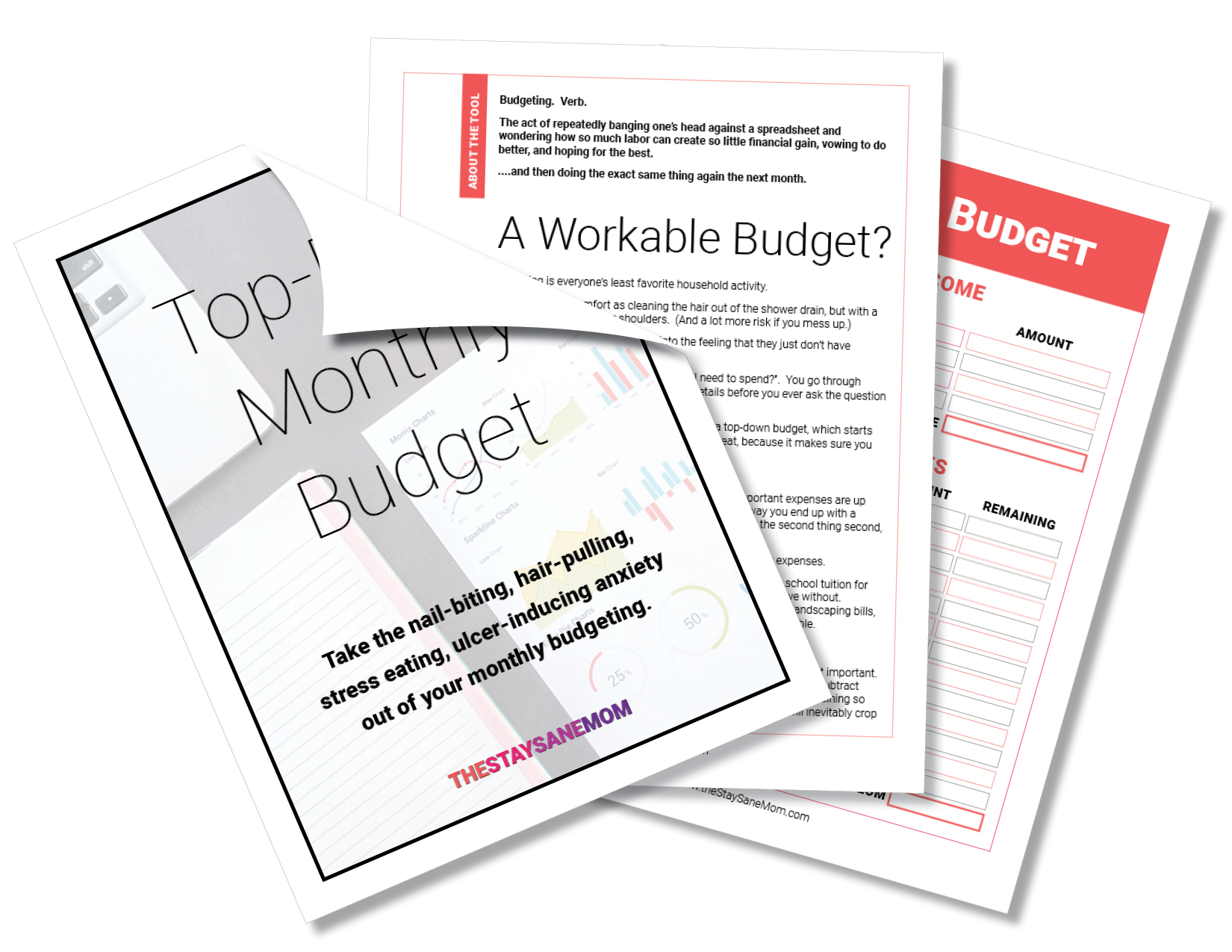How to Create a Top-Down (aka Failproof) Budget
-Budget.jpg)
How to Create a Top-Down (aka Failproof) Budget
This post will take you through and almost fail-proof budget creation strategy that will help you prioritize your expenses to make sure what's coming in is actually paying the important stuff first.
Written by Liz Bayardelle, PhD | See Comments | Updated 05/29/2019
Want to cut to the chase?
Failproof Monthly Budget

How to Create a Top-Down (aka Failproof) Budget
This post contains some affiliate links for your convenience. Click here to read my full disclosure policy.
We all know that budgeting is everyone's least favorite household activity.
It has the same level of lovely discomfort as cleaning the hair out of the shower drain, but with a lot more importance and pressure on your shoulders. (And a lot more risk if you mess up.)
I have talked a lot about your budget sheet I passed my various financial blogs, but this one deals with a very specific problem that many people have with their budget:
“I can’t make ends meet!”
The Problem with Many Budgets
A lot of times when people make budgets, they run into the feeling that they just don't have enough money to cover all of their expenses.
Especially in today's gig economy, where multiple jobs and two working parent homes are quite commonplace, it can be increasingly hard to feel like your paycheck actually covers all of your expenses.
While sometimes it is really true that what you're able to bring in isn't enough to cover your basic expenses (and we’ll talk about this below), most of the time when this feels like it's the case, it might have to do with how you're creating your budget.
This post will take you through and almost fail-proof budget creation strategy that will help you prioritize your expenses to make sure what's coming in is actually paying the important stuff first, and to help you get a feel for what is necessary and what might be “budget fluff”.
The Top-Down Solution
A top-down budget is one that starts from the big picture and then gets more detailed.
In this case, it’s one that starts from your monthly income, rather than your expenses. This is great, because it makes sure you don’t actually budget to spend more than you earn.
Most budgets are created based on the question “what do I need to spend?”. You go through spending categories, expense types, and all kinds of other details before you ever ask the question “do I have enough money for this to work?”.
This makes this a great way to create your first attempt at a budget, because you never lose sight of the bottom line (that you have to make more money than you spend).
Your Nerdy Present (A Preview)
At the end of this post you're going to get a link to Google Sheets spreadsheet.
This is freed up copy of the actual sheet I used to create our household budget. This sheet helps you implement the top-down solution to create your own budget.
First, you enter your total monthly income, then it gives you an abundance of lines to add expenses (and reorder them in order of importance).
The beauty is that each time you add an expense, it subtracts it from your monthly income so you can see the exact moment you’re budgeting to spend money you don’t have.
How to Order Your Expenses
When you're creating your budget, you want to make sure the most important expenses are up top, trailing down to the least important expenses at the bottom. This way you end up with a prioritized list of what to do with your money. You pay the first thing first, the second thing second, and make your way down the list until you run out of money.
However, the benefit of making a budget before hand is making sure that instead of running out of money, you have stopped spending and those lower expenses that can't get paid don't actually occur.
To make this more simple, I use three basic categories when ordering my expenses.
-
Non-negotiable expenses
-
Pretty important expenses
-
Things that would be nice
These are pretty self-explanatory, but I'll go over them anyway because there are some important distinctions.
Non-Negotiable Expenses
These are the expenses that has to be paid no matter what.
This includes stuff like your mortgage, your car payments, school tuition for your kids, and a basic amount of food.
You want to make sure you input these expenses before you play around with anything else, because it will give you a baseline for the minimum amount you have to earn each month.
If you find yourself getting in trouble before you finish listing your non-negotiable expenses, you either need to take another look at how much money you're earning (and consider picking up another shift at work or adopting a side hustle...more on this below) reevaluate your definition of non-negotiable. If you're including things like new clothes, dining out, or video games in your “non-negotiable” category, it might be time for some tough self-talk.
This is really just for the stuff that you literally couldn't live without: food, medical bills, shelter, education.
Pretty Important Expenses
This is probably going to be your biggest category.
This is for the expenses like your cable bill, your Netflix subscription, your landscaping bills, and other stuff that is pretty essential to your life, but can't be described as 100% non-negotiable.
Stuff might travel back and forth from one category to another every once in awhile as your life evolves. As a starting out professional, new clothes might be a pretty important expense, because you need to look professional at work and you don't have anything but hoodies in your closet, but after a year of accruing new clothes that could get bumped down to the next category.
It's totally fine for your budget to be flexible, because life never stand still. Reevaluate every once in awhile and make sure everything is in the proper order of priority.
Things That Would Be Nice
this is the category where everything else lives.
This can be as expensive as you want, just treat it as a wishlist not a set in stone budget. You can definitely do “aspirational budgeting” in this section, because if nothing else it will allow you to see how much extra money you would have to bring in in order to have your dream budget work out perfectly.
The important part here is that you do draw a line in the sand when your monthly income runs out. Nothing below that line should be treated as an actual expense, but rather a future goal for once you make more money for months.
What to Do If There’s Just Not Enough
This section really does deserve a blog all to itself, but I'll give you the greatest hits here.
When you look at your budget and feel like they're really just isn't enough money to cover your expenses, there are two obvious ways to fix the problem:
-
Make more money
-
Spend less money
Make More Money
There are entire blogs, websites, and areas of the internet devoted to how to make more money. If you are currently employed, it could be as simple as picking up a few extra shifts, doing research on what you could do to get a raise, or simply asking your boss for more hours.
Yes, this does involve sacrifice, but adulting is hard. I really have nothing else for you other than adult thing is really hard.
You can also consider picking up a second job, a side hustle, or freelancing work if you have a marketable skill. If you really feel like you don't have enough money to cover even the non-negotiable expenses section of your budget, it might be time for some soul-searching on how to rearrange your life.
Spend Less Money
This second option is actually the one I would pursue first, before attempting to pick up a second job or making any Draconian changes and employment.
The first easy thing to do is to check your categories to make sure everything is prioritize properly and you're not being too ambitious. Check how much you're planning to spend on food and evaluate is that is being spent on necessary groceries or fast food or meals out. To quote the almighty Dave Ramsey, “sometimes you have to live like no one else if you want to live like no one else”.
Another thing you can do is look for expenses that aren't really that necessary. Do you have subscriptions to Netflix, Hulu, and cable? How often do you actually use these services? Could you get by on just one gym membership instead of two? Maybe you could work out at home for a while? Go through your expenses line by line and see if there's anything you can cut out. (You could also get professional help from advisors like Cory Grandel to make it easier for yourself.)
You can also look for things that are costing you more than they should. If you have the same auto insurance company you've always had, but I think your premiums might be a little high, you could check out something like cheapautoinsurance.co to double-check that you're actually paying what you should.
Whatever your situation is, try to look at it with an objective eye on what is a reasonable amount for normal person to pay for that expense, rather than what you need in that category. For some reason, this change in wording makes me a lot more rational in my head.
Accounting for Emergencies
One thing you can always be certain of is that emergencies will happen.
I've actually written an entire blog post on my one simple trick to hit your budget every month. Spoiler alert, this involves an extra savings account that you put aside money in for expenses that happen on a yearly basis and emergencies, so you had something to pull from when you have to pay for surprise medical bills, ambulance fees, kiddie expenses, or things that unexpectedly break around the home.
I would add one category in your non-negotiable expenses section that is a small amount of money (maybe a hundred dollars or a few hundred if you can spare it) that gets paid along with your absolutely mandatory bills. However, instead of “paying” this amount, you contribute it to a specific savings account that is only for emergencies or yearly expenses.
You don't want to make this two larger than a mouse, because it is getting paid with your mandatory bills. (Too large of an amount will sink your budget.)
However, putting aside a little each month will make your next emergency seem less life-ending or budget-breaking.
The Role of Savings
Outside of your emergency savings account, you do want to contribute to savings.
If you're just spending the same amount you earn each month, you're not making any financial progress and that makes no one feel good.
I would say that you want 30% to 40% of your savings categories in your pretty important expenses, and 60% to 70% in your things that would be nice category.
The pretty important savings account for things like future college tuition for kids, necessary renovations, or a retirement fund for you and your spouse. These things are necessary, but if you don't pay them every month the world won't explode (the way it would if you didn't pay your mortgage).
The savings that would be nice or are for things like yearly family vacations, Home Improvements, and other things that aren't absolutely essential, but are still outside of your monthly budget. These are the ones that are most fun, but part of the whole adulting business is putting the important stuff first, not the fun stuff first.
(Sorry, dude.)
In terms of your spreadsheet, you want to treat savings contributions like an expense. They get their own line and a mouse, just like your car payments would, but instead of spending the money you contribute it to a savings account.
And with that mention of your spreadsheet, let me explain to you your present.
Your Nerdy Present
The button below will give you your own copy of my budgeting spreadsheet.
This is the way you create your budget is your starting one for the first time, or you don't like your current one and need to reassess.
The process is simple. you only need two input three things.
First, you want to put your monthly total income in the big, orange-outlined box.
Next, you put in all your expenses, starting from the most important down to the least important. The expense name goes in column A, the amount of that expense goes in column B. These are the only things you need to change, as the spreadsheet will do the rest for you.
After use in put it all your expenses, you can click and drag the rose to rearrange the expenses in priority order. The formula is calculating how much money you have left will automatically update as the row is moved, so feel free to drag stuff from one category to another to your heart's content.
The number in the top right will show you how much you have left in your budget total, but you also see a running total as each item is calculated, so it shows you how much you have left in your budget at that point in your priority list.
Again, this is how we made our family budget and I highly recommend giving it a go, even if you already have a budget created. Looking at things from a “how much money do I have left?” standpoint gives you a new perspective on your finances, even if you already are a fantastic budgeter.
Give it a go and let me know how it works!
Happy budgeting!
Start Your Next Step
Failproof Monthly Budget

Get Sanity, Delivered to Your Inbox.
Care to Share?
-Budget-1.jpg)
-Budget-2.jpg)
-Budget-3.jpg)
-Budget-4.jpg)
About the Author

Liz Bayardelle, PhD
Founder | Contributor
Liz (or Dr. Mommy, as her toddler started calling her after learning what a PhD was) is the happily sleep-deprived mom of a toddler (and professional raccoon noise impersonator), a sparkle-clad kidnado, a teenage stepdaughter, 200 cumulative pounds of dog, and herd of dustbunnies (if daily vacuuming doesn't occur). During nights and naptimes, she uses her PhD in business psychology as an author, speaker, and consultant. She also serves as an executive and principal for three companies, two of which she co-founded with her very patient (and equally exhausted) husband.





